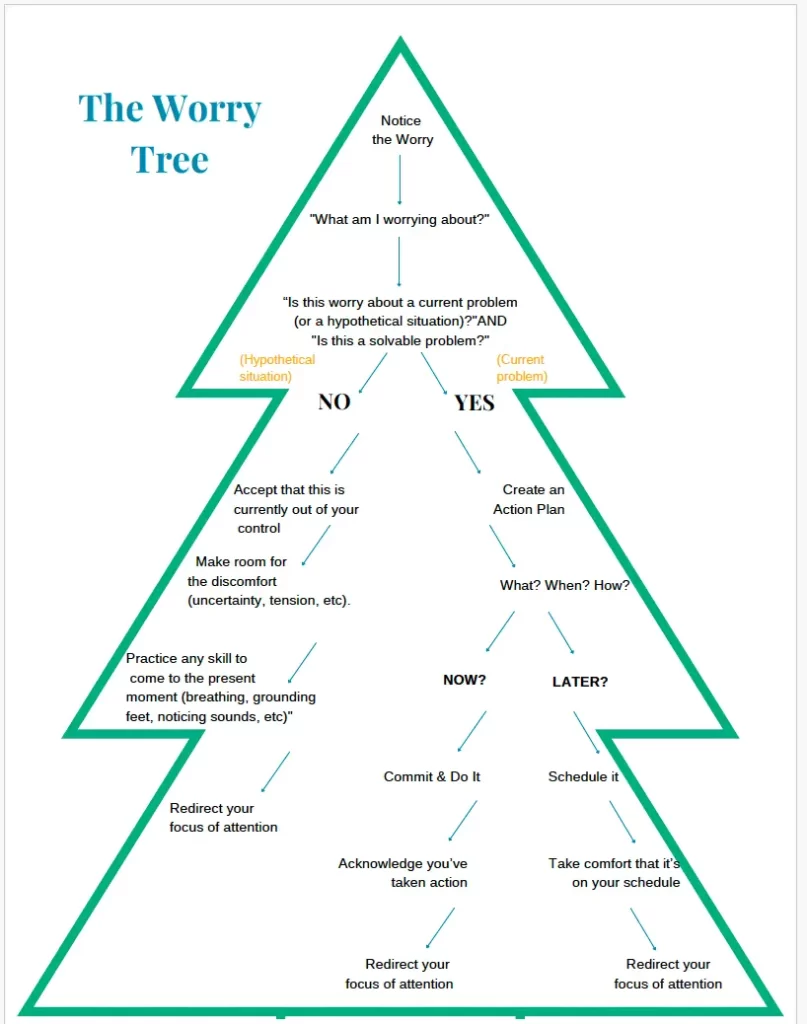Curb Anxiety with The Worry Tree

Do you often find yourself trapped in a cycle of worry every day? Feeling overwhelmed when your mind constantly bounces from one fear to the next, never letting it go? Then, the tool I will review in this blog can be beneficial! If you prefer to watch the video, you can watch it below. If not, keep scrolling to read the blog.
Table of Contents
Watch Video: “The Worry Tree”
Read blog on “Curb Anxiety With The Worry Tree”
The tool, “The Worry Tree,” is commonly used for individuals struggling with Generalized Anxiety Disorder. But even if you don’t have Generalized Anxiety Disorder, if you tend to worry, this is a helpful tool for you. I’ve slightly adapted it to be more congruent with how I explain it to my clients.This tool is edited/adapted from Butler, G., Hope, T. (1995). Manage your mind. Oxford: Oxford University Press.
Let’s start by showing you the completed Worry Tree, and then I’ll go through it step by step, explaining some different things.

If you prefer a downloadable version, check the box below.
The Worry Tree:First Step
Let’s start at the top of The Worry Tree. The first step is just noticing that you’re worrying, so it’s beneficial to notice this before you do anything about it or intervene; you have to notice that you’re getting caught or stuck by it.
You’ll instinctively know often because you’ve been thinking about this repeatedly; maybe you’ve discussed it with different people. Perhaps you can tell by the timespan of how long this has been consuming your internal energy.
It’s also helpful to consider the impact it may be having on your overall well-being. Are you more irritable? Is it something that surfaces every night when you try to sleep or the first thing you think about when you wake up? Either way, the first step is just noticing that you’re worrying; you’ll have to practice getting good at that.
The Worry Tree: Second Step
The next step is to ask yourself, “What am I worrying about?” You can be as detailed or brief as you want to get a general sense of the current issue causing you distress.
There might be multiple things causing you distress, but for now, pick one. You’ll go through the worry tree, and then you can use this worry tree for the next worry. Either way, ask yourself and think about what current situation is causing you distress. Is this an existing problem or a hypothetical problem?
A hypothetical problem could be something you’re just thinking about in the future. It’s not an issue you’re facing or might ever face. Additionally, consider whether it’s a solvable problem right now. If the answer is no, it’s not a current and solvable problem, then you would go into the hypothetical path.
The Worry Tree: Follow Hypothetical Worry’s Path
The next step in the hypothetical path would be to accept that this is currently out of your control. Internally acknowledge that if it’s a theoretical or future-oriented problem that’s not solvable, there’s nothing you can do about it.
Move on to the next step in this track, which involves acknowledging or making room for the discomfort. I added this because the fact that you’re worrying about it and repeatedly thinking about it usually indicates that this is something important to you. It’s not something you can just let go of. People often say, “Stop worrying, let it go,” but if only it were that easy.
Acknowledge that you’ll have to make room for the distress that commonly accompanies worrying. In my experience with clients who worry, I often see difficulties with uncertainty, being in limbo, not knowing, or navigating the gray areas of certain situations. Dealing with uncertainty and sitting with it can be challenging. I encourage you to practice making room for any tension or internal experience that comes with it.
Taking it further, practice any skills that help you return to the present moment. This is especially crucial when dealing with uncertainty and future-oriented hypothetical situations. Ground yourself in the current moment using skills from your toolbox, such as breathing exercises or grounding techniques.
Notice sounds, remind yourself of the current date and time – anything that brings you back to this moment. It’s helpful to remember that in this exact moment, it’s not happening right now, so make room and return to the present.
You can also check out the following mindfulness exercise:
The last step is redirecting your attention or re-engaging. Intentionally refocus your attention and energy on what you were doing before the worry took over. Re-engage with your tasks or activities to move away from the state of being stuck or caught up in worry into something else that feels meaningful.
This isn’t about ignoring the worry but subtly acknowledging it, going through the process, and making room for any internal discomfort. Redirect your attention and focus in a way that feels intentional and purposeful. You’ve already noticed the worry, gone through the process, and now you’re making room for the internal discomfort, so redirect your attention to where you want it to be.
The difficulty with worry often lies in its ability to pull your attention away constantly. It’s like continually being internally interrupted by another incoming message, except your mind sends you another SOS that distracts you. Practice redirecting your attention and focusing on what matters to you.
The Worry Tree: Follow Solvable Worry’s Path
Now, let’s explore the other scenario. If it is a current and solvable problem, create an action plan. Worry can be helpful if channeled appropriately, but there needs to be a point where you accept limitations. Create a detailed action plan – what needs to be done, the steps involved, and the timeline. Dive into the specifics of solving the problem. Do you need more information or need to consult with others? Figure that out.
If it’s something you can do now, commit to the action. Follow through with the committed action, channeling your energy into resolving the problem and doing it immediately. It’s crucial to acknowledge that you’ve already taken steps to address the worry in a helpful way that propels you forward in your life.
After implementing the action plan, recognize that anything within your control has been done. This is a powerful reminder as you navigate the worry process, allowing you to close off that particular worry loop.
Now, refocus your attention and energy on something else. Turn the page once you’ve completed the steps associated with that worry. If you tend to worry, it’s common for another concern to arise. If that happens, you can practice the same process again.
Re-acknowledge that you’ve successfully moved through a worry. If the answer is that you can’t do anything about the new concern immediately, understand that you can revisit the worry tree process when needed. This tool helps you navigate through worries effectively.
If the action needed for the worry isn’t something you can do immediately, schedule it out. Be specific about when you’ll address it, whether in a week or when you have time. If you’re missing information, schedule obtaining that piece of information. Remind yourself that it’s on your schedule, finding comfort in the fact that you have a plan. When the worry resurfaces, acknowledge it, thank your mind for the reminder, and redirect your attention to something else.
I encourage you to at least commit to going through this worry tree tool once, following it through, and finishing it off. This process can help you turn the page on worries and prevent them from consuming excessive time and energy in your life.
Sign up for my email newsletter to receive mental health tips, exercises, and book recommendations straight to your inbox! As always, I encourage you to continue nurturing your mind, body, and soul, whatever that looks for you!
